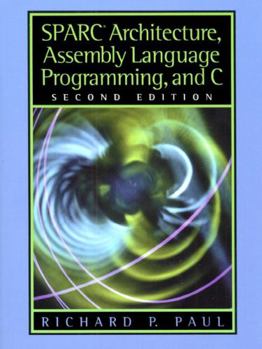SPARC Architecture, Assembly Language Programming, and C
Select Format
Select Condition 
Book Overview
Written from a programmer's perspective, this long-awaited revision introduces the SPARC assembly language to readers early on. Other introductory material encompasses making use of UNIX tools. KEY TOPICS: Further coverage includes a formal definition of the von Neumann machine, its relationship to programmable calculators, and to the JAVA bytecode and JAVA virtual machine. MARKET: For engineers, computer scientists, and people...
Format:Paperback
Language:English
ISBN:0130255963
ISBN13:9780130255969
Release Date:July 1999
Publisher:Pearson
Length:528 Pages
Weight:1.70 lbs.
Dimensions:1.1" x 7.0" x 9.2"
Customer Reviews
5 ratings
Dated but remains an excellent source of reference
Published by Thriftbooks.com User , 16 years ago
This book is excellent considering the time it was produced and definitely an superb piece of work. But an update is needed as technologies have progressed much over the last 8-9 years; e.g. Sun Microsystems have incorporated the GCC compiler into their latest architectures like the x86-Opteron; to compare and offer new perspectives on the subject maybe advances in compiler technology, if any etc would be terrific.
very clear, down-to-earth style
Published by Thriftbooks.com User , 20 years ago
This is one the best books I've read on computing. The presentation is down to earth, as in "here's how a computer do such and such, it's not thaat difficult, see?' which i like very much. It's a complete contrast to Hennesy & Patterson's 'Computer Architecture', which spends most of its pages surveying grand technologies this and that without really getting down to details. If you like to understand & build things yourself rather than admiring other peoples 'technologies', I think you'd like this book. For me, it's also a great place to learn how to write a compiler, because the approach is clear & simple, not overfed with formal-language theory that's the norm in compiler design texts.
Great book to learn Assembly.
Published by Thriftbooks.com User , 21 years ago
This book discusses everything in detail that you need to know in order to learn Assembly and work with assembly.It even discusses and explains Assembly code that does exactly what some of the C Control Structure (for(), while(), etc) code looks like in assembly.This books contains two chapters that discuss different number systems as well as how adding, subtracting, multiplying, and division work with binary numbers including the Assembly code.Any one that wants to have a better grasp of how the machine actually runs your compile program or wants to write/read assembly should get this book.
I didn't find it that bad, actually
Published by Thriftbooks.com User , 22 years ago
I found the book quite useful as an introduction to SPARC assembly language. There is a lot of material on program optimization, which could be skipped or read. The extensive use of the m4 preprocessor gets slightly annoying at times, but the programs generally remain easy to read. The reason for a four star review is that although I feel the book does not cover the subject in a lot of depth, it wasn't very user-friendly to the absolute beginner either. As such, the book would make a good textbook for a course, but it is not that good for the independent learner. By the way, I'm basing this on the first edition.
This is an excellent book about SPARC Assembly Language.
Published by Thriftbooks.com User , 24 years ago
For anyone interested in learning about the SPARC Architecture/Instruction Set (and RISC machines in general) this book is invaluable. It is especially useful for optimizing iterative and decision making C/C++ constructs. In fact, if one follows the tenets espoused in this book, one can learn to hand optimize time-critical sections of C/C++ code that is better than that produced by gcc or cc - the aversion of the UNIX community to write any code in assembly language notwithstanding. The book really delivers what its rather verbose title implies. That is, a really outstanding feature of the text is the way in which the author translates the standard C/C++ constructs to their low-level counterparts. He does this in stages - creating a variety of examples that progress from functional but grossly inefficient code fragments up to superbly succinct variants. I have used this book in a one semester undergraduate course at the University of Delaware for three years and have also used excerpts from it when I have taught the MIPS Architecture. There is no other book that treats RISC (or CISC) architecture from Professor Paul's relational premise, with which I totally agree. Having taught INTEL stuff for 10+ years, I firmly believe that much of its content could be effectively utilized in CISC courses. The book is also used as the secondary text in the graduate compiler course at U.D.The book is not without flaws, most of which are because of an incredible number of typographical errors - I have counted over 60 just involving commas! Hopefully the new edition which I believe is due to be published soon will have been edited/typeset with more care. Also, there are some minor changes to the gnu software (gdb and gcc) that need to be upgraded.




